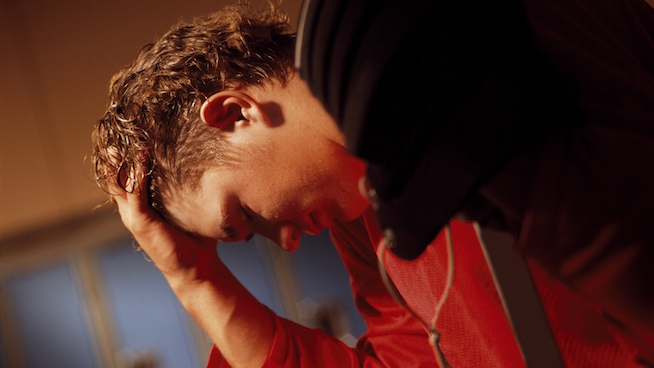The Wingate Test: The Hardest 30 Seconds of Your Life
![]() Performing an exercise for 30 seconds might not seem like a big deal. Challenging, no doubt, but totally doable.
Performing an exercise for 30 seconds might not seem like a big deal. Challenging, no doubt, but totally doable.
Well, the Wingate Test might change your opinion.
After pedaling for only 30 seconds on a bike, I’ve seen elite Division I hockey players run for the puke bucket. (Unfortunately, I once had a similar experience.) Although the test is brief, the 30 seconds feels like an eternity. When you’re finished, it seems like a surreal experience, having gone from totally fine to completely and utterly thrashed.
RELATED: 13 Fitness Challenges That Will Destroy You
To be frank, the Wingate Test sucks. You’ll never hear any enthusiasm about it. But, it might also be an effective conditioning tool you can add to your workouts.
What is the Wingate Test?
The Wingate Test requires a cycle ergometer, which is an expensive stationary bike that’s typically only found in labs. The resistance provided by this type of bike can be precisely calibrated to a percentage of your body weight (we’ll leave the exact resistance for the lab.) Resistance can be applied immediately electronically or by dropping the weight, as shown in the video below.
[youtube video=”e-uaKhOAn_A” /]To start the test, you gradually start pedaling faster. Once you’re up to speed, resistance is applied and you must pedal as hard as humanly possible for the entire 30 seconds. Other people in the lab usually scream words of encouragement throughout the test.
After the test, the resistance you used is multiplied by your speed at various points to provide data on your anaerobic energy system. Specifically, it measures max power output (anaerobic power) and your ability to maintain your power (anaerobic capacity).
Obviously, the Wingate Test has a direct correlation to cycling, but it also applies to any sprint-based sport, such as football, hockey and basketball. Your anaerobic system provides energy for short bursts of strength and power, such as sprints. A more efficient anaerobic energy system allows you to sprint faster for a longer period of time—a critical attribute of a well-conditioned athlete.
The Wingate Workout
It’s unrealistic to do the Wingate Test outside a lab—most gyms don’t have a cycle ergometer. So unless you make a trip to a lab, you won’t be able to test your anaerobic power this way.
With that said, it’s possible to use the Wingate Test protocol as the basis of a conditioning workout. A 2010 study found that an interval workout with a 30-second max cycle sprint and four-minute rest periods between sets was more effective at improving both the anaerobic and aerobic energy systems than 10-second cycle sprints with either two or four minutes of rest.
You can do this with virtually any stationary cycle—albeit with less precision than a cycle ergometer. Gradually get yourself up to speed and then crank up the resistance as much as you can handle. If you finish the 30 seconds and aren’t totally exhausted, you didn’t go high enough. Repeat this for four to six sets.
Don’t get me wrong. This is not a fun workout. And you shouldn’t do it more than once per week, because it seriously fatigues the body. However, the discomfort might be worth it when you get back on the field or court.
RELATED: This Exercise May Make You Puke
RECOMMENDED FOR YOU
MOST POPULAR
The Wingate Test: The Hardest 30 Seconds of Your Life
![]() Performing an exercise for 30 seconds might not seem like a big deal. Challenging, no doubt, but totally doable.
Performing an exercise for 30 seconds might not seem like a big deal. Challenging, no doubt, but totally doable.
Well, the Wingate Test might change your opinion.
After pedaling for only 30 seconds on a bike, I’ve seen elite Division I hockey players run for the puke bucket. (Unfortunately, I once had a similar experience.) Although the test is brief, the 30 seconds feels like an eternity. When you’re finished, it seems like a surreal experience, having gone from totally fine to completely and utterly thrashed.
RELATED: 13 Fitness Challenges That Will Destroy You
To be frank, the Wingate Test sucks. You’ll never hear any enthusiasm about it. But, it might also be an effective conditioning tool you can add to your workouts.
What is the Wingate Test?
The Wingate Test requires a cycle ergometer, which is an expensive stationary bike that’s typically only found in labs. The resistance provided by this type of bike can be precisely calibrated to a percentage of your body weight (we’ll leave the exact resistance for the lab.) Resistance can be applied immediately electronically or by dropping the weight, as shown in the video below.
[youtube video=”e-uaKhOAn_A” /]To start the test, you gradually start pedaling faster. Once you’re up to speed, resistance is applied and you must pedal as hard as humanly possible for the entire 30 seconds. Other people in the lab usually scream words of encouragement throughout the test.
After the test, the resistance you used is multiplied by your speed at various points to provide data on your anaerobic energy system. Specifically, it measures max power output (anaerobic power) and your ability to maintain your power (anaerobic capacity).
Obviously, the Wingate Test has a direct correlation to cycling, but it also applies to any sprint-based sport, such as football, hockey and basketball. Your anaerobic system provides energy for short bursts of strength and power, such as sprints. A more efficient anaerobic energy system allows you to sprint faster for a longer period of time—a critical attribute of a well-conditioned athlete.
The Wingate Workout
It’s unrealistic to do the Wingate Test outside a lab—most gyms don’t have a cycle ergometer. So unless you make a trip to a lab, you won’t be able to test your anaerobic power this way.
With that said, it’s possible to use the Wingate Test protocol as the basis of a conditioning workout. A 2010 study found that an interval workout with a 30-second max cycle sprint and four-minute rest periods between sets was more effective at improving both the anaerobic and aerobic energy systems than 10-second cycle sprints with either two or four minutes of rest.
You can do this with virtually any stationary cycle—albeit with less precision than a cycle ergometer. Gradually get yourself up to speed and then crank up the resistance as much as you can handle. If you finish the 30 seconds and aren’t totally exhausted, you didn’t go high enough. Repeat this for four to six sets.
Don’t get me wrong. This is not a fun workout. And you shouldn’t do it more than once per week, because it seriously fatigues the body. However, the discomfort might be worth it when you get back on the field or court.
RELATED: This Exercise May Make You Puke












